Year 9 Exam > Year 9 Notes > Year 9 Science IGCSE (Cambridge) > Chapter Notes: Photosynthesis and The Carbon Cycle
Photosynthesis and The Carbon Cycle Chapter Notes | Year 9 Science IGCSE (Cambridge) PDF Download
| Table of contents |

|
| Photosynthesis |

|
| More about Photosynthesis |

|
| The Carbon Cycle |

|
| Climate Change |

|
Photosynthesis
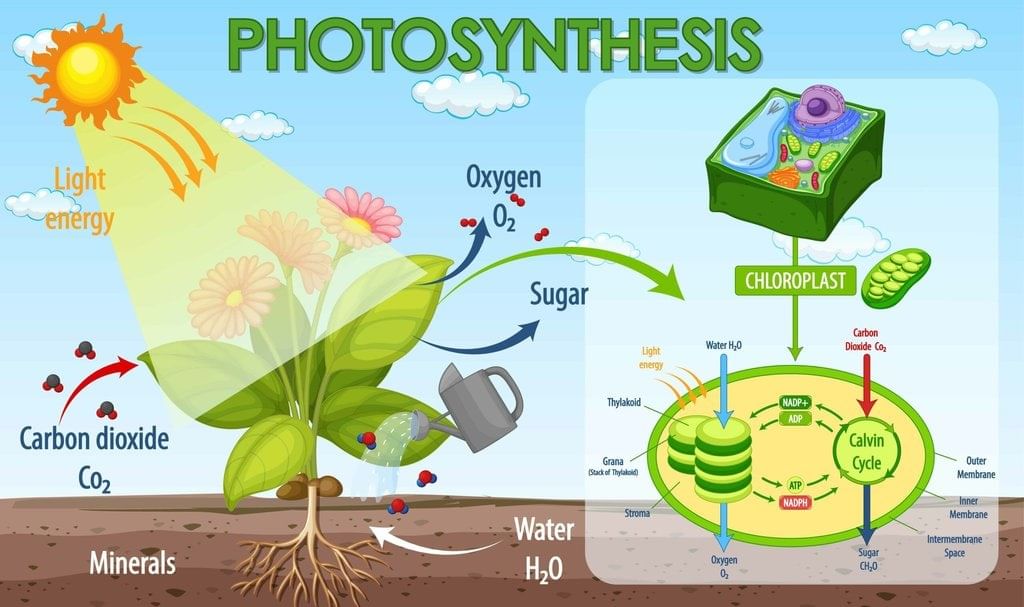
How Plants Make Food
- Photosynthesis is the process by which plants produce their own food, with the term derived from Greek words "photo" meaning light and "synthesis" meaning making, thus indicating the creation of food using light.
- During photosynthesis, plants utilize three essential components: water, which is absorbed from the soil through roots; carbon dioxide, which is taken in from the air; and energy, which is harnessed from sunlight.
- The green pigment chlorophyll, located within certain cells in the leaves, captures sunlight’s energy, enabling the chemical reactions necessary for photosynthesis.
- In this process, sunlight’s energy facilitates a chemical reaction where water and carbon dioxide combine, resulting in the production of two new substances: glucose, a type of sugar, and oxygen, a gas.
- The word equation for photosynthesis is expressed as: water + carbon dioxide → glucose + oxygen, summarizing the transformation of inputs into outputs.
- Photosynthesis predominantly occurs in the leaves of plants, where chlorophyll and other necessary conditions are most abundant, optimizing the process.
Why is Photosynthesis Important?
- Photosynthesis is crucial because it provides chemical energy in the form of nutrients, such as glucose and other carbohydrates, which serve as an energy source for most organisms on Earth.
- Plants convert sunlight’s energy into glucose and carbohydrates, which store a portion of the original solar energy, making it accessible to other life forms.
- Through food chains, animals acquire energy by consuming plants, thereby transferring the energy captured during photosynthesis from one organism to another.
- Most of the energy in the world’s food supply originates from plants, underscoring the foundational role of photosynthesis in global ecosystems.
- Photosynthesis produces oxygen as a byproduct, which is released from plant leaves into the atmosphere, constituting approximately 20% of the air we breathe.
- Oxygen is essential for respiration in both plants and animals, enabling them to convert nutrients into usable energy.
- When Earth formed about 4.6 billion years ago, its atmosphere contained almost no oxygen, making it inhospitable for oxygen-dependent life.
- Scientists believe that oxygen began accumulating in the atmosphere when bacteria started photosynthesizing, long before plants appeared.
- Plants did not exist on Earth until approximately 4.7 million years ago, meaning early photosynthesis was driven by bacteria, laying the groundwork for later life forms.
- Without the onset of photosynthesis, oxygen-dependent animals would never have evolved, highlighting its critical role in shaping Earth’s biosphere.
More about Photosynthesis
Chloroplasts and Chlorophyll
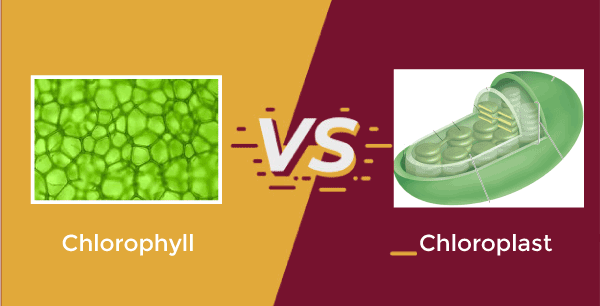
- Chlorophyll is a vital component of photosynthesis, as it absorbs sunlight’s energy, which drives the reaction between water and carbon dioxide.
- Chlorophyll is housed within chloroplasts, specialized organelles found inside certain plant cells, serving as the primary site of photosynthesis.
- Not all plant cells contain chloroplasts, so only those with these organelles, predominantly in leaves, are capable of photosynthesizing.
- In most plants, leaf cells have the highest concentration of chloroplasts, where carbon dioxide and water react to produce carbohydrates and oxygen.
- A field of plants, such as lettuces, can be likened to a giant carbohydrate factory, efficiently converting raw materials into energy-rich compounds.
- On warm, sunny days, plants often produce more carbohydrates than they immediately require, allowing them to store excess energy.
- Plants store surplus carbohydrates as starch within chloroplasts, reserving it for use during periods of low sunlight, such as nighttime or winter months.
- Testing a leaf for starch is a practical method to determine whether it has been actively photosynthesizing, as starch indicates carbohydrate production.
Inside a Leaf
- Photosynthesis occurs within chloroplasts, which are primarily located in cells within the middle layers of a leaf’s structure.
- Leaves are thin, which facilitates sunlight penetration to reach chloroplasts, ensuring efficient energy capture for photosynthesis.
- Chloroplasts require a steady supply of water and carbon dioxide, both of which are essential reactants in the photosynthetic process.
- Water is transported to leaf cells through the plant’s vascular system, specifically via veins, providing a consistent supply for photosynthesis.
- Carbon dioxide enters the leaf from the surrounding air through small pores called stomata (singular: stoma), which regulate gas exchange.
- Inside the leaf, air spaces between cells allow carbon dioxide to diffuse easily to chloroplasts, supporting the chemical reactions of photosynthesis.
Minerals and Plant Growth
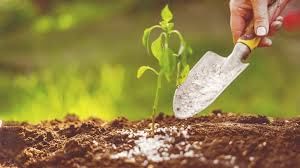
- Farmers apply fertilizers to fields, such as those growing wheat, to enhance crop growth and increase yield, which refers to the quantity of crop harvested.
- Fertilizers contain minerals, essential nutrients that plants require in small amounts, absorbed from the soil through their roots.
- When soil lacks sufficient minerals, plant growth is restricted, preventing crops from reaching their full potential in size and productivity.
- Magnesium is a critical mineral needed to synthesize chlorophyll, the green pigment that enables plants to capture sunlight for photosynthesis.
- A deficiency in magnesium causes leaves to turn yellow instead of green, indicating low chlorophyll levels, which reduces the plant’s ability to photosynthesize effectively.
- Reduced photosynthesis due to magnesium deficiency hinders plant growth, as the plant cannot produce enough energy-rich compounds.
- Farmers test soil to identify specific mineral deficiencies, allowing them to apply fertilizers only where necessary, optimizing crop health and resource use.
- Advanced farming technologies utilize global positioning satellites (GPS) integrated with machinery to enhance fertilizer application precision.
- In modern tractors, screens display the farmer’s exact location in the field alongside soil test results, enabling precise control over fertilizer distribution.
- Nitrate, another vital mineral, supplies nitrogen atoms, which are necessary for converting carbohydrates into proteins, essential for plant growth.
- Proteins are crucial for forming new cells, enabling plants to develop and expand, supporting overall growth and vigor.
- Nitrogen is also required for chlorophyll production, and a lack of it leads to small plants with dying leaves, as seen in maize (corn) crops under nitrogen deficiency.
- Without adequate nitrogen, plants struggle to synthesize proteins and chlorophyll, severely limiting their growth and photosynthetic capacity.
The Carbon Cycle
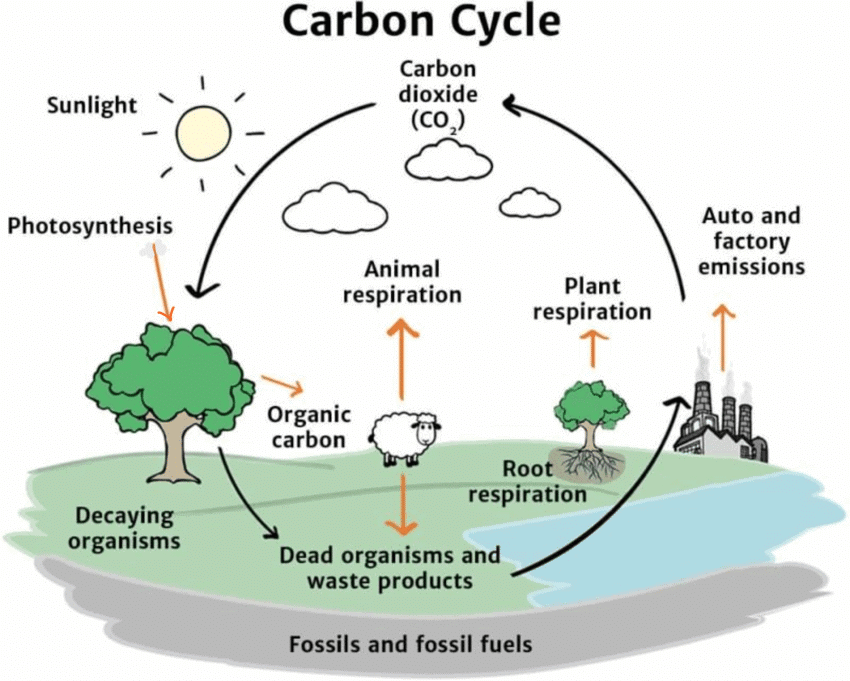
Carbon and Living Organisms
- Carbon is an element, denoted by the symbol C, classified as a non-metal that occurs naturally in various forms.
- Examples of carbon forms include diamonds, valued for their hardness, and graphite, commonly mistaken as “lead” in pencils.
- Living organisms do not use carbon in its elemental form, such as diamonds or graphite, but require it as part of chemical compounds.
- Carbon is a key component of carbohydrates, proteins, and fats, all of which are essential compounds that make up the cells of living organisms.
- Plants play a critical role in supplying these carbon-containing compounds by absorbing carbon dioxide from the air during photosynthesis.
- Carbon dioxide, a compound consisting of carbon and oxygen atoms, provides the carbon needed to synthesize carbohydrates in plants.
- Plants use the carbohydrates produced in photosynthesis to create proteins and fats, both of which also incorporate carbon atoms.
- Animals, including humans, obtain carbon-containing nutrients by consuming plants or other animals, integrating carbon into their own cellular structures.
- Decomposers, such as bacteria and fungi, acquire carbon by breaking down waste products and dead matter from plants and animals, recycling it within ecosystems.
Returning Carbon Dioxide to the Air
- A significant portion of the carbon dioxide absorbed by plants during photosynthesis is returned to the atmosphere through respiration in plants, animals, and decomposers.
- The respiration process is represented by the equation: glucose + oxygen → carbon dioxide + water, producing carbon dioxide as a byproduct.
- In animals, carbon dioxide produced in cells during respiration is exhaled, releasing it back into the surrounding air.
- All organisms respire continuously, but plants release more carbon dioxide at night when photosynthesis ceases, relying solely on respiration.
- Decomposers also respire as they break down organic waste, releasing carbon dioxide into the atmosphere, contributing to the carbon cycle.
Fossil Fuels and Combustion
- When organisms die, their remains are not always quickly decomposed, especially in oxygen-poor environments like deep ocean floors.
- In such conditions, decomposers cannot respire effectively due to insufficient oxygen, allowing organic matter to accumulate and become buried under sediment.
- Over millions of years, high pressure and heat transform these buried remains into fossil fuels, including coal, oil, and natural gas.
- Most fossil fuels used today were formed hundreds of millions of years ago, preserving carbon from ancient organisms.
- Oil and natural gas originate from tiny marine organisms that died and settled on the seabed, now extracted through rigs with deep pipes, such as those off West Africa.
- Coal forms from the remains of plants that grew in ancient swamps, buried and compressed over millions of years into carbon-rich deposits.
- Coal is mined and utilized as a fuel for cooking, heating homes, or, primarily, in power stations to generate electricity, releasing stored energy.
- Fossil fuels contain carbon derived from the carbohydrates, proteins, and fats of the organisms from which they were formed.
- Combustion, the burning of fossil fuels, combines this carbon with atmospheric oxygen, producing carbon dioxide that is released back into the air.
- The carbon cycle describes the movement of carbon from the atmosphere through organisms, into fossil fuels, and back to the air via processes like photosynthesis, respiration, feeding, and combustion.
- Fossil fuels are distinct from fossils, which are the preserved remains or traces of organisms turned to rock, retaining their shapes.
- In contrast, fossil fuels, such as oil and gas, do not resemble organisms and are not rocks, named for their ancient formation underground alongside fossils.
Climate Change
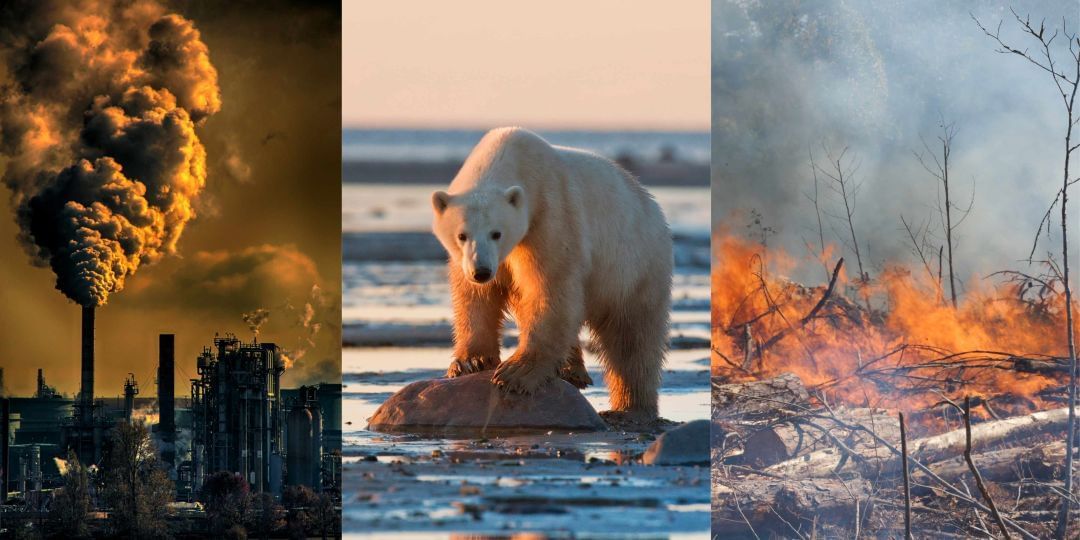
Greenhouse gases
- Carbon dioxide and methane are classified as greenhouse gases, which play a critical role in trapping heat energy in the atmosphere.
- These gases help maintain Earth's warmth, making it habitable; without any carbon dioxide, the Earth would be a frozen, uninhabitable place.
- Current atmospheric carbon dioxide levels are excessively high, contributing to adverse climate effects.
- The carbon cycle shows that some atmospheric carbon is stored in fossil fuels over long periods.
- Fossil fuels, formed over millions of years, remain buried until extracted and burned, releasing stored carbon as carbon dioxide back into the atmosphere.
- Increasing carbon dioxide concentrations in the atmosphere are driving changes in Earth's climate.
Climate change in the past
Ice ages
- Climate refers to the long-term patterns of temperature, wind, and rainfall on Earth.
- Approximately 2 billion years ago, Earth experienced its first known ice age.
- Since then, Earth has alternated between warm periods with no ice at the poles and colder periods, known as ice ages, with ice present at the poles.
Snowball Earth
- Around 650 million years ago, Earth may have been entirely covered in ice and snow, an event referred to as 'Snowball Earth' or 'Slushball Earth' if not fully frozen.
- During this period, continents were positioned differently than they are today.
- The exact causes of Snowball Earth remain unclear to scientists.
Asteroids colliding with each other
- Around 470 million years ago, a collision between two asteroids in space, between Earth and Mars, produced significant dust.
- This dust blocked sunlight and heat from reaching Earth's surface, triggering an ice age.
- The resulting colder climate caused ice caps to expand further from the poles and sea levels to drop.
Asteroids colliding with Earth
- Approximately 67 million years ago, an asteroid struck Earth near the coast of Mexico, causing massive devastation.
- The impact acted like a massive bomb, generating shock waves and extreme temperatures around the crater.
- The collision ejected large amounts of rock and dust into the atmosphere, reducing sunlight reaching Earth's surface.
- This led to decreased photosynthesis, disrupting food chains, and a colder climate due to less solar heat.
- The climate changes from this event are believed to have caused the extinction of dinosaurs and up to 75% of Earth's species, marking a mass extinction.
- Globally, about 175 known asteroid impact craters exist, including one in the USA, over 1 km wide and 170 m deep, formed 50,000 years ago.
Could other objects collide with Earth?
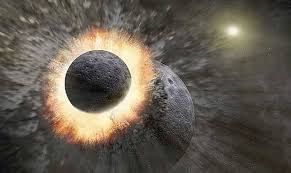
- Objects smaller than asteroids are called meteoroids; when they enter Earth's atmosphere, they become meteors, often called shooting stars due to their rapid, bright appearance.
- Meteors typically burn up in the atmosphere due to friction heat, posing little risk.
- In 2013, a meteor explosion over Russia caused shockwaves that shattered windows.
- Meteoroids that reach Earth's surface are called meteorites, with about 500 impacting annually.
- Large objects can cause local or global damage upon impact.
- Since 1998, scientists have monitored potential threats from space objects, assessing risks based on the object's mass or diameter and its closest approach to Earth.
- An asteroid passing farther from Earth may pose a greater risk than a closer one if it has greater mass.
- In 2014, asteroid 2006 DP14, measuring 200 m x 400 m, passed 2.4 million km from Earth, considered a potential risk due to its size.
- A collision from an asteroid like 2006 DP14 could cause an explosion equivalent to 20 million tonnes of explosives.
Climate change today and in the future
- For approximately 2,000 years, Earth's climate has been relatively stable, allowing predictable seasonal patterns for rainfall and temperature.
- Stable climate patterns have enabled people to plan agricultural activities, such as choosing crops and timing planting and harvesting.
- Currently, Earth's mean temperatures are rising due to increased atmospheric carbon dioxide concentrations.
- Carbon dioxide, a greenhouse gas, traps heat near Earth's surface, and higher concentrations result in more trapped heat.
- Between 1880 and 2016, Earth's mean temperature increased, with data showing the difference from the 1880 baseline temperature.
Impacts of climate change
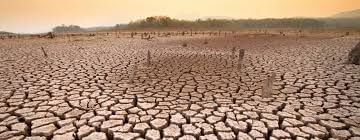
More extreme weather events
- Rising temperatures add more energy to the atmosphere, increasing the likelihood of extreme weather events like hurricanes and typhoons.
- Scientists observe a potential increase in the frequency and severity of storms, though natural variability makes it challenging to confirm.
- In 2019, Tropical Cyclone Idai struck southern Africa, killing over 1,300 people and causing severe flooding that destroyed homes and fields.
- While individual storms like Cyclone Idai cannot be directly attributed to climate change, the apparent rise in storm frequency and intensity suggests a link.
Less predictable rainfall
- Climate change disrupts rainfall patterns, complicating agriculture in some regions.
- Rains may be delayed, absent, or excessively heavy, leading to droughts or flooding.
- In 2019, monsoon rains in Pakistan, India, Nepal, and Bangladesh were late and heavier than usual, causing floods that affected millions.
- Failed rains can lead to crop losses, while prolonged droughts increase wildfire risks, impacting people, plants, and animals.
- Australian wildfires followed extended droughts, highlighting the broader ecological consequences.
Rising sea levels
- Increasing global temperatures contribute to rising sea levels through thermal expansion of water and melting ice caps and glaciers.
- Glaciers are retreating, with ice coverage diminishing in valleys as temperatures rise.
- Sea levels are rising at approximately 3 mm per year.
- By the end of the century, over 600 million people may be at risk from flooding due to sea-level rise.
- Coastal megacities like Shanghai, Mumbai, and Los Angeles are particularly vulnerable to rising sea levels.
The document Photosynthesis and The Carbon Cycle Chapter Notes | Year 9 Science IGCSE (Cambridge) is a part of the Year 9 Course Year 9 Science IGCSE (Cambridge).
All you need of Year 9 at this link: Year 9
|
2 videos|39 docs|9 tests
|
FAQs on Photosynthesis and The Carbon Cycle Chapter Notes - Year 9 Science IGCSE (Cambridge)
| 1. What is the process of photosynthesis? |  |
Ans.Photosynthesis is the process by which green plants, algae, and some bacteria convert light energy into chemical energy in the form of glucose. This process takes place in the chloroplasts of plant cells, where chlorophyll captures sunlight and uses it to convert carbon dioxide and water into glucose and oxygen.
| 2. Why is photosynthesis important for life on Earth? |  |
Ans.Photosynthesis is crucial for life on Earth as it is the primary source of organic matter for nearly all organisms. It produces oxygen, which is essential for the respiration of most living creatures, and it helps regulate atmospheric carbon dioxide levels, thus playing a key role in maintaining the Earth's climate.
| 3. How does the carbon cycle relate to photosynthesis? |  |
Ans.The carbon cycle is a natural process that involves the exchange of carbon among the atmosphere, oceans, soil, and living organisms. Photosynthesis is a key component of this cycle, as it captures carbon dioxide from the atmosphere and converts it into organic compounds, which are then used by other organisms for energy and growth.
| 4. What impact does climate change have on photosynthesis? |  |
Ans.Climate change affects photosynthesis by altering temperature and precipitation patterns, which can influence plant growth and productivity. Increased levels of carbon dioxide may enhance photosynthesis in some plants, but extreme weather events, droughts, and changing climates can negatively impact ecosystems and agricultural yields.
| 5. What are the main factors that affect the rate of photosynthesis? |  |
Ans.The rate of photosynthesis is influenced by several factors, including light intensity, carbon dioxide concentration, temperature, and water availability. Optimal conditions for these factors can enhance photosynthesis, while unfavorable conditions can hinder the process.
Related Searches















